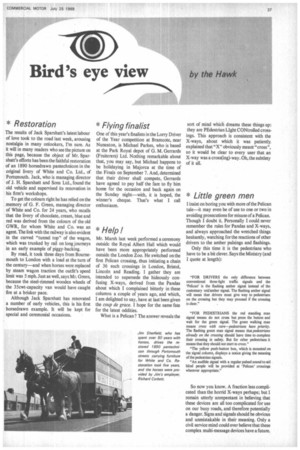Bird's eye view
Page 39

If you've noticed an error in this article please click here to report it so we can fix it.
by the Hawk * Restoration
The results of Jack Sparshatt's latest labour of love took to the road last week, arousing nostalgia in many onlookers, I'm sure. As it will in many readers who see the picture on this page, because the object of Mr. Sparshatt's efforts has been the faithful restoration of an 1890 horsedrawn pantechnicon in the original livery of White and Co. Ltd., of Portsmouth. Jack, who is managing director of J. H. Sparshatt and Sons Ltd., found the old vehicle and supervised its renovation in his firm's workshops.
To get the colours right he has relied on the memory of G. F. Green, managing director of White and Co. for 24 years, who recalls that the livery of chocolate, cream, blue and red was derived from the colours of the old GWR, for whom White and Co. was an agent. The link with the railway is also evident in the curved "tunnel top" of the wagon, which was trunked by rail on long journeys in an early example of piggy-backing.
By road, it took three days from Bournemouth to London with a load at the turn of the century—and when horses were replaced by steam wagon traction the outfit's speed limit was 5 mph. Just as well, says Mr. Green, because the steel-rimmed wooden wheels of the 35cwt-capacity van would have caught fire at a brisker pace.
Although Jack Sparshatt has renovated a number of early vehicles, this is his first horsedrawn example. It will be kept for special and ceremonial occasions.
* Flying finalist
One of this year's finalists in the Lorry Driver of the Year competition at Bramcote, near Nuneaton, is Michael Parkes, who is based at the Park Royal depot of G. M. Gerrards (Fruiterers) Ltd. Nothing remarkable about that, you may say, but Michael happens to be holidaying in Majorca at the time of the Finals on September 7. And, determined that their driver shall compete, Gerrards have agreed to pay half the fare to fly him home for the occasion and back again on the Sunday night—with, it is hoped, the winner's cheque. That's what I call enthusiasm.
* Help !
Mr. Marsh last week performed a ceremony outside the Royal Albert Hall which would have been more appropriately performed outside the London Zoo. He switched on the first Pelican crossing, thus initiating a chain of 36 such crossings in London, Bristol, Lincoln and Reading. I gather they are intended to supersede the hideously confusing X-ways, derived from the Pandas about which I complained bitterly in these columns a couple of years ago, and which, I am delighted to say, have at last been given the coup de grace. I hope for the same fate for the latest oddities.
What is a Pelican ? The answer reveals the sort of mind which dreams these things up: they are PEdestrian Light CONtrolled crossings. This approach is consistent with the X-ways, about which it was patiently. explained that "X" obviously meant "cross", so it would be clear to every user that an X-way was a cross(ing)-way. Oh, the subtlety of it all.
* Little green men
I insist on boring you with more of the Pelican tale—it may even be of use to one or two in avoiding prosecutions for misuse of a Pelican. Though I doubt it. Personally I could never remember the rules for Pandas and X-ways, and always approached the wretched things hesitantly, watching for the reactions of other drivers to the amber pulsings and flashings.
Only this time it is the pedestrians who have to be a bit clever. Says the Ministry (and I quote at length):
"FOR DRIVERS the only difference between conventional three-light traffic signals and the 'Pelican' is the flashing amber signal instead of the customary red/amber signal. The flashing amber signal will mean that drivers must give way to pedestrians on the crossing but they may proceed if the crossing is clear."
"FOR PEDESTRIANS the red standing man signal means do not cross but press the button and wait for the green signal. The green walking man means cross with care—pedestrians have priority. The flashing green man signal means that pedestrians already on the crossing should have time to complete their crossing in safety. But for other pedestrians it means that they should not start to cross."
-The yellow push-button box, which is mounted on the signal column, displays a notice giving the meaning of the pedestrian signals.
"An audible signal with a regular pulsed sound to aid blind people will be provided at 'Pelican' crossings wherever appropriate."
















































































































